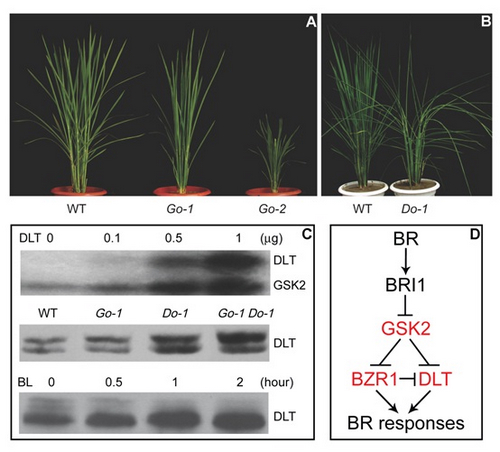Brassinosteroid, usually called BR for short, has been proved to have huge potential in improving crop yield through promoting plant growth and optimizing plant architecture, or in enhancing stress resistance of plant. These virtues have boosted the research on BR signaling pathway in the past three decades.
Rapid progress has been made in Arabidopsis, a model plant widely used for plant biology research. However, the BR signaling pathway in rice, one of the most important crops, remains largely unknown. Recently, Dr. Chengcai Chu’s group from the Institute of Genetics and Developmental Biology, the Chinese Academy of Sciences, has make a great advance in understanding rice BR signaling pathway.
The group members have firstly identified a rice dwarf mutant named dlt from the lab’s mutant library. By characterization of the mutant phenotype and trying different hormones, they found dlt is indeed a BR-insensitive mutant. They cloned the gene and found it encodes a new member of the GRAS family, members of which have been proved to play significant roles in diverse plant growth and developmental processes. In 2009, they published their research results on the Plant Journal.
After that, they carried an in-depth study on DLT function mechanism in BR signaling pathway. They firstly speculated that DLT might be phosphorylated by a GSK3-like kinase, then they cloned the kinase gene named GSK2 and proved the key function of GSK2 in BR signaling pathway. Further, by utilization of biochemical, genetic and molecular biological approaches, they demonstrated GSK2 could directly interact with DLT and phosphorylate DLT to repress DLT activity. In addition, they proved that GSK2 could also phosphorylate another transcription factor named BZR1, and BZR1 can inhibit DLT transcription. Finally, they constructed a network containing GSK2, DLT and BZR1 in regulation of BR signaling pathway in rice.
Cloning a gene and analyzing its function are very regular things for a molecular biology scientist. However, Chu’s group has gone deep into the protein level analysis among multiple genes interaction, which is rarely reached in rice functional genomics research so far. Now, with the strong bases established in this project, the group is moving forward to construct a more comprehensive network of BR signaling pathway in rice.
This work has recently been published on Plant Cell, the highest impact journal in plant biology field. The first author, Hongning Tong, now a Research Assistant in Chu’s group, started this project six years ago. The work was supported by grants from Chinese Academy of Sciences, Ministry of Science and Technology, Ministry of Agriculture of China, and National Natural Science Foundation of China.
AUTHOR CONTACT:
Chengcai Chu, Group Leader
Institute of Genetics and Developmetnal Biology, Chinese Academy of Sciences, Beijing, China.
Email: ccchu@genetics.ac.cn

(Imaged by Hongning Tong et al.)
Figure. GSK2 phosphorylates DLT to regulate BR signaling in rice. (A) Overexpression of GSK2 leads to BR-deficient phenotype. (B) Overexpression of DLT leads to BR-overdose phenotype. (C) GSK2 can phosphorylate DLT, and BR can induce DLT dephosphorylation. (D) Rice BR signaling network constructed in this work.



